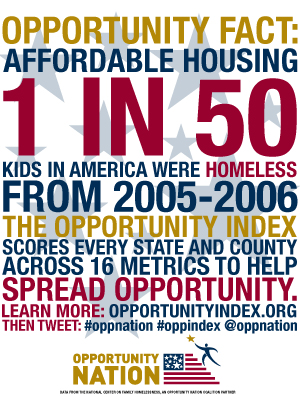Index Indicator Blog Series: Affordable Housing Improves Opportunity for Low-Income Children
•An adequate supply of affordable housing is one of the most pressing needs facing Americans today. The U.S. Department of Housing and Urban Development reports that family homelessness increased 20 percent from 2007 to 2010. The supply of affordable housing has shrunk nationwide, and the current shortage is estimated to be over six million housing units.
The Opportunity Index identifies affordable housing as one of the 16 indicators that affect a region’s ability to provide opportunity to its residents. Affordable housing is defined as the percentage of households spending less than 30 percent of their annual income on rent and utilities. In other words, those who allocate more than half of their income to rent are considered “severely burdened renters” according to the Joint Center for Housing Studies at Harvard University. The number of severely burdened renters has increased substantially over the past decade, from 20 to 26 percent. Therefore, the need for affordable housing is increasing. According to Opportunity Nation coalition partner National Center on Family Homelessness, one in 50 kids in America experienced homelessness between 2005 and 2006.

A report from the Urban Institute, a nonpartisan economic and social policy research organization, demonstrates how access to high-quality, affordable housing can serve as a powerful lever for educational success for children. “Housing as a Platform for Improving Education Outcomes among Low-Income Children” finds that when children grow up in a stable, comfortable home environment, they are more able to focus on their schoolwork.
As affordability, quality, stability and neighborhood safety increase, test scores and years of schooling increase. Disruptions such as changing schools, absenteeism and behavioral problems decrease. Also, when low-income parents spend less of their money on rent, they are able to spend it on other necessities, such as healthcare and food.
A 2011 study by Kids Count on the number of children in low-income households that had to spend more than 30 percent of their income on shelter found that more than half of all low-income children in the United States, lived in “severely burdened renter” households. From a low of 45 percent in South Dakota – the only state that reported fewer than 50% of children in this situation – to a high of 83 percent in New Jersey, this study illustrates how far we still have to go in investing in families that need affordable housing.
Fortunately, there are effective national organizations committed to expanding the supply of affordable housing, including Opportunity Nation’s coalition partner, Habitat for Humanity. With the help of volunteers and donations, Habitat for Humanity builds and fixes homes for families in need of affordable housing. The homeowners help build their house, investing sweat equity in the project. The loan that they pays is used entirely to build homes for other families. Habitat for Humanity volunteers have build more than 200,000 homes. If you would like to help them continue this work, you can be a volunteer, donor or advocate.
Opportunity Index Dimenson: Jobs & Local Economy
Indicator: Affordable Housing — Households spending less than 30% of income on housing (%)
Source: U.S. Census Bureau, American Community Survey
Rationale for inclusion: High housing costs trigger painful tradeoffs between safe, adequate housing and other necessities, such as education, food, and transportation. An inability to find affordable housing in a neighborhood with good schools and adequate transportation constrains opportunity for adults, who may face a long and arduous commute to distant parts of town with more employment, and for children, whose long-term opportunities may be diminished by an inadequate public education.








